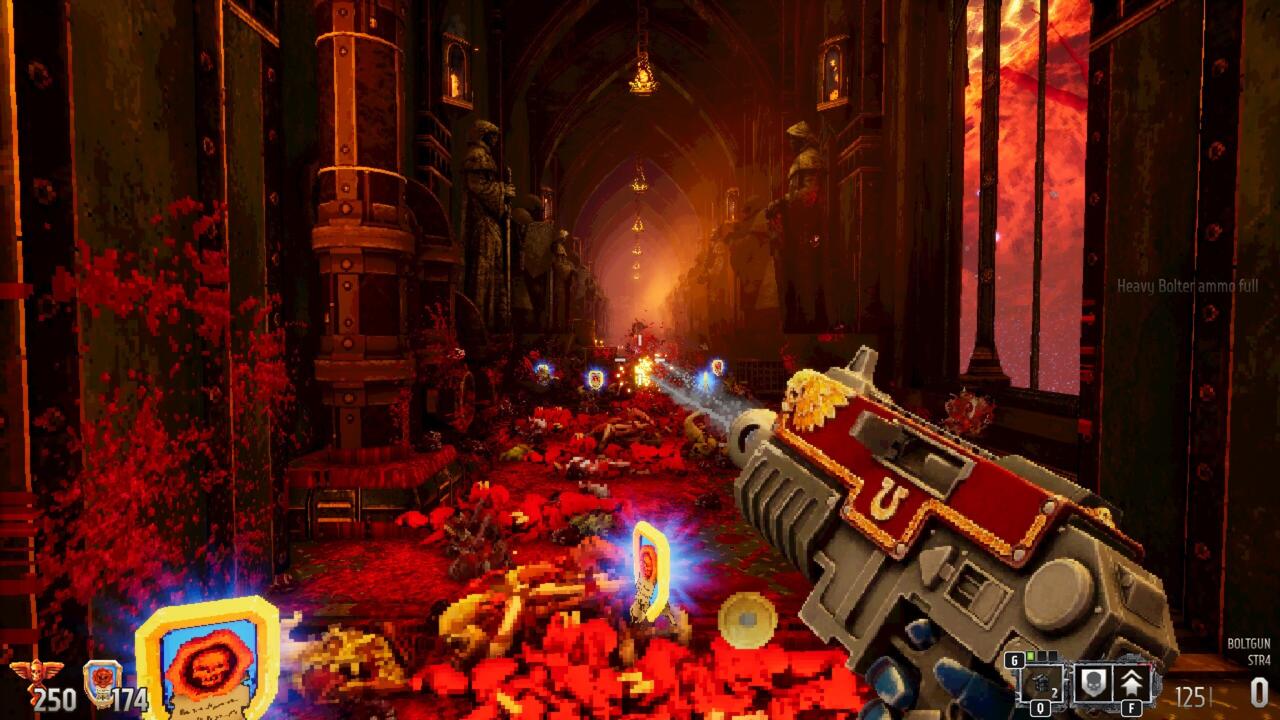The Boltgun is perhaps Warhammer 40,000’s most iconic weapon, yet it took until now for a video game to really nail its pulverizing impact. The Space Marine’s Bolter (as it’s commonly known) is not the machine gun equivalent it’s often portrayed as in other games. This powerful firearm is essentially a rapid-fire rocket launcher, capable of penetrating almost any armor and then blowing up the Imperium’s enemies from the inside out. Developer Auroch Digital clearly understood the assignment with Warhammer 40,000: Boltgun, as the eponymous weapon is tremendously fun to use as you rip and tear your way through eight hours of ’90s-inspired first-person shooting. The Bolter roars with an emphatic racket, and each pull of the trigger packs an almighty punch, ferociously propelling these explosive rounds through flesh and bone until the battlefield is little more than a crimson pile of viscera and sinewy chunks.
Classic retro shooters like Unreal Tournament and Quake are obvious inspirations behind Boltgun’s fast-paced and frenetic combat, but it’s the original Doom that feels like the principal source of reverence. The use of 2D sprites alongside 3D environments, color-coded keycard hunting, and garish, over-the-top violence all harken back to id Software’s seminal title. Boltgun is unashamedly a Doom clone with a Warhammer skin, but Auroch has sprinkled in some modern touches, too, from the dizzying amount of particle effects on screen at any one time, to the intricate level of detail found on each and every weapon, to the sheer scale of some of its environments. Verticality is also heavily emphasized, with a jump and mantle animation giving you the chance to scramble and leap off ledges, much like in 2016’s Doom reboot. All of this leads to Boltgun managing to capture a tangible sense of nostalgia while also tapping into the fluidity and pacing of a contemporary shooter. It’s a familiar but potent mix, resulting in a viscerally satisfying game that’s relatively easy to pick up and play.
The story is suitably paltry, however, providing just enough setup to explain why you’re on a distant planet mowing down anything that breathes in the name of the Inquisition. As battle-hardened Space Marine Malum Caedo, you’re dispatched to the Adeptus Mechanicus Forge World of Graia to investigate some concerning goings-on. As it turns out, the Ad Mech were running experiments that have predictably gone awry and spawned a Chaos invasion. After a botched landing leaves you as the lone survivor, you’re put to work cleansing the forces of Chaos armed with an ever-expanding supply of powerful weaponry.
Boltgun’s assortment of 41st-millennium armaments is at the heart of everything great about its fast-paced and sanguinary action. There’s no denying that the titular Bolter is the star of the show, but every other weapon proves its worth, making this one of the more appealing arsenals in the genre. If you’re not a Warhammer fan, having no prior knowledge isn’t a barrier to entry in any way, but those who are will appreciate the attention to detail as each weapon looks and functions as it should. The Plasma Gun, for instance, is extremely deadly but volatile. It might deal massive damage, but it’s also prone to overheating, at which point it can malfunction and hurt you, too. The Meltagun, on the other hand, unleashes an energetic beam of heat that can dissolve armor in a heartbeat, proving especially useful against tenacious enemies like the imposing Chaos Terminators. Even the Chainsword, which is always available as a melee option, can cut through the toughest foes given enough time.
Boltgun [manages] to capture a tangible sense of nostalgia while also tapping into the fluidity and pacing of a contemporary shooter. It’s a familiar but potent mix, resulting in a viscerally satisfying game that’s relatively easy to pick up and play
Part of what makes each of these murderous tools so fun to use is the tremendous audio and visual feedback across the board. Guns feel hefty and consume the soundscape with a cacophony of whirring thermal energy, thunderous bedlam, and the clink of spent casings crashing against the ground. Basic enemies go down in one or two shots and almost everything explodes on death, leaving behind buckets of blood and heretical failure.
Ammunition for the more powerful weapons in your arsenal is relatively scarce, however, which ensures that the Boltgun remains a constant companion throughout your journey. The Bolter was my go-to when dealing with cannon-fodder enemy types such as human Cultists and swarms of plague-spewing Nurglings, but it’s capable of taking down Chaos Space Marines in a pinch. Hidden secrets scattered throughout each level also provide temporary upgrades that can boost its damage output, such as the devastatingly explosive Kraken ammo. Despite this, I never felt like I had to “save” certain weapons to the point where I wouldn’t end up using them. Ammo may not be especially plentiful, but there’s enough to encourage you to bust out the big guns when dealing with Boltgun’s most resilient opponents. It just makes sure never to undermine the Bolter, which in turn strengthens the viability of your entire arsenal.
Juggling your firearms is vitally important when it comes to dealing with the variety of enemies you’ll encounter as you trek across Graia. Even the weakest can pose a threat if they attack in numbers, so strafing, judicious use of the sprint button, and perpetual motion are the keys to survival. Boltgun’s levels are fairly linear for the most part, but many of its environments are quite expansive. In between all of the compact corridor shooting, you’ll also uncover these vast combat arenas where you’re tasked with purging every enemy before moving on. Space Marines are basically walking tanks, yet you’re still surprisingly nimble, able to fluidly traverse the battlefield while maintaining a palpable sense of weight as your colossal footsteps reverberate around the room and shake the screen. It’s here where you’re assaulted on all sides by all manner of Cultists and Chaos Daemons, from Plague Toads, which leap around the battlefield spitting green acid at you, to the Pink Horrors that split into Blue Horrors upon death. Boltgun is often at its best in these moments, where the exhilaration of barely surviving by the skin of your teeth accentuates its thrilling action.

Gallery
Unfortunately, these combat arenas also shine a spotlight on an issue id Software solved back in 2016’s Doom. In true boomer shooter fashion, the health bar in Boltgun doesn’t replenish over time. Instead, each level is filled with both health and armor pick-ups for you to grab when the need arises. This is par for the course, but being forced to run around, searching for healing items and ammo can take you out of the action for prolonged periods of time. Doom’s Glory Kills and Chainsaw rectified this issue, and I can understand why Auroch Digital opted not to replicate a feature wholesale, but the old-school alternative is inherently archaic and detracts from the experience. Some of the levels are also quite samey, making it easy to get turned around because so many corridors look almost identical. The fact that there’s no map only intensifies this issue.
Despite these faults, Warhammer 40,000: Boltgun is an extremely fun game with a contagious reverence for classic ’90s shooters and the Warhammer universe at large. Its entire arsenal of flesh-combusting weapons is a joy to use, and its simple gameplay loop is kept fresh by a steady supply of new armaments and enemy types to squash under the almighty boot of the Imperium. It’s not trying to revolutionize the genre and that’s perfectly fine; it’s the type of game to hire avid Warhammer fan Rahul Kohli (Gears of War 5, Midnight Mass) to voice its protagonist, only to make him exceptionally easy to miss unless you stumble upon the “Taunt” button. There aren’t any gameplay advantages to hitting this button, but you do get to hear Kohli relish in delivering some Space Marine-appropriate lines as he nails the angry, regal tone. That’s almost worth the price of admission alone.
























